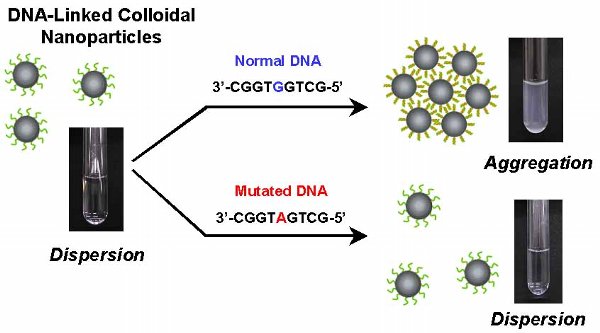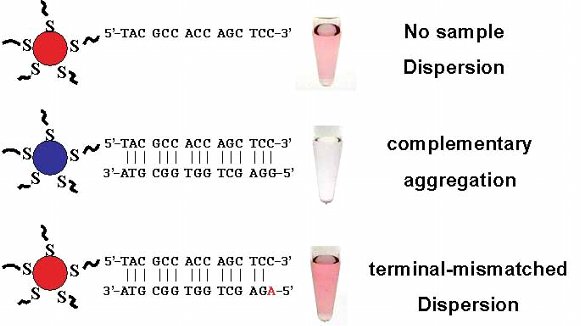Gene Diagnosis Using DNA-Linked
Colloidal Nanoparticles
|
We
have proven that the non-crosslinking aggregation is not a unique property of
the DNA-PNIPAAm system. It also occurs with DNA-modified gold nanoparticles. The
aggregation can be detected by colorimetric change of the colloidal solution
into purple. The nanoparticles aggregate together when the probe DNA is
hybridized with fully complementary DNA. In contrast, the terminal-mismatched
DNA did not cause any discernible change. The non-crosslinking aggregation
has unusual sensitivity for single-base mismatch at the terminus opposite to
the anchored side.
|
References
|
(1) |
Sato K., Onoguchi M., Sato Y., Hosokawa
K., and Maeda M.; �Non-cross-linking
gold nanoparticle aggregation for sensitive detection of single-nucleotide
polymorphisms: Optimization of the particle diameter� Anal. Biochem., 350, 162-164 (2006). |
|
(2) |
Sato
K., Hosokawa K., and Maeda M.; �Non-cross-linking gold nanoparticle
aggregation as a detection method for single-base substitutions� Nucleic
Acids Research, 33, 1, e4 (2005). |
|
(3) |
Mori
T. and Maeda M.: �Temperature-responsive formation of colloidal nanoparticles
from poly(N-isopropylacrylamide) grafted with single-stranded DNA� Langmuir 20,
313-319 (2004). |
|
(4) |
Tang
Z. L., Takarada, T., Sato Y., and Maeda M.: �Colloidal nanoparticles from
poly(N-isopropylacrylamide)-graft-DNA for single nucleotide discrimination
based on salt-induced aggregation: extension to long target DNA� Chem. Lett.
33, 1602-1603 (2004). |
|
(5) |
Sato
K., Sawayanagi M., Hosokawa K., and Maeda M.: "Single-base mutation
detection using neutravidin-modified polystyrene nanoparticle
aggregation." Anal. Sci. 20, 893-894 (2004). |
|
(6) |
Sato,
K., Hosokawa, K., and Maeda, M.: "Rapid aggregation of gold
nanoparticles induced by non-cross-linking DNA hybridization" J. Am.
Chem. Soc. 125 (27), 8102-8103 (2003). |
|
(7) |
Mori
T. and Maeda M.: �Stability Change of DNA-Carrying Colloidal Particle Induced
by Hybridization with Target DNA� Polym. J. 34, 624-628, (2002). |
|
(8) |
Tang
Z. L., Mori T., Takarada T., and Maeda M.: �Single Nucleotide Polymorphisms
(SNPs) Assay Using Reversible Association and Dispersion of DNA-Linked
Colloidal Nanoparticles� Nucleic Acids Res. Suppl. 1, 165-166, (2001). |
|
(9) |
Tang
Z. L., Mori T., Takarada T., and Maeda M.: �Recognition of DNA Sequence and
Chain Length by Using DNA-Linked Nanoparticle� Anal. Sci. Supple. 17,
a357-a359, (2001). |

